A constellation near the south pole of the sky, whose brighter stars form an irregular polygon, clearly looming against the almost starless background between Grus and the Hydrus, by the bright star Achernar of Eridanus. In the Tucana is the Small Magellanic Clouds, a small irregular galaxy, a companion to our own. The second important object is the globular cluster 47 Tucanae, the most beautiful in the sky according to the subjective feelings of observers.
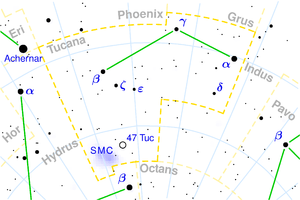
α Tuc - The brightest star of the constellation has an apparent magnitude of 2.91 and an orange hue. It is located 62 light-years away from Earth.
β Tuc - not only an optical, but also a physical binary star. Two almost equally bright components with magnitudes of 4.4 and 4.5 are separated by 27.1", so we can distinguish them well in a good binocular. Both are further doubled, which we can only perceive in a telescope. Additionally, at a distance of 9.3' to the southeast, we can observe a third component with a magnitude of 5.1, which is actually also a close binary star.
δ Tuc - An easily distinguishable double star. The primary component has a brightness of 4.8 magnitude and is separated by 7 arcseconds from a companion with a brightness of 9 magnitude, which can be separated by at least a 100 mm telescope.
κ Tuc - A binary star composed of stars with magnitudes 5 and 8, which can be resolved with a small telescope.
NGC 104
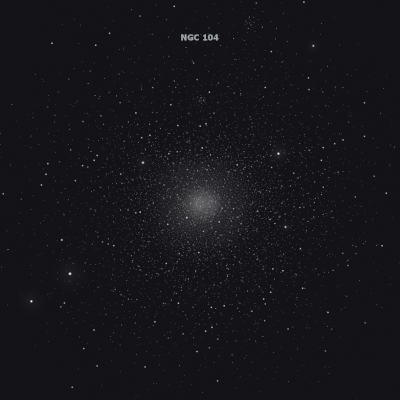
Nicolas-Louis de Lacaille discovered the nebulous appearance of NGC 104 = Lac I-1 = D 18 = 47 Tucanae = h2322 in 1751-1752 with a 1/2-inch telescope at 8x during his expedition to the Cape of Good Hope. It appeared "like the nucleus of a fairly bright comet." He placed it in group I, consisting of nebulae without stars. The cluster was noted, though, as a "star" in Bayer's Uranometria, which was first published in 1603. The designation "47 Tuc" comes from Bode's extension of Flamsteed numbers to the southern constellations (these are not used today except for 47 Tuc and 30 Dor). With his 9-inch speculum reflector, James Dunlop logged "(47 Toucan, Bode) this is a beautiful large round nebula, about 8' diameter, very gradually condensed to the centre. This beautiful globe of light is easily resolved into stars of a dusky colour. The compression to the centre is very great, and the stars are considerably scattered south preceding and north following." His sketch in figure 1 of his catalogue shows a beautifully resolved, elongated cluster.
John Herschel observed it for the first time on 11 Apr 1834 and logged "the great cluster preceding the Nubecula Minor. Estimated dia of the denser portion 5'; of the whole (not, however, including loose stragglers) 8'. Stars 14..16 mag. and one of 12th mag N.p. the centre. Excessively compressed. (N.B. In a sweep below the pole, when of course owing to the low altitude much of the light was lost.)" His observation of 12 Aug 1834 reads: "A most glorious cluster. The stars are equal, 14th mag., immensely numerous and compressed. Its last outliers extend to a distance of 2 min, 16 sec in RA from the centre. It is compressed to a blaze of light at the centre, the diameter of the more compressed part being 30 arcsec in RA. It is at first very gradual, then pretty suddenly very much brighter in the middle. It is completely insulated. After it has passed, the ground of the sky is perfectly black throughout the whole breadth of the sweep. There is a double star 11th mag. preceding the centre (Pos. 226.5 - 6.5 arcsec in RA from centre of neb.)" On 21 Sep 1835 he wrote: "Fills the field with its stragglers, condensation in three distinct stages, first very gradually, next pretty suddenly, and finally very suddenly very much brighter in the middle up to a central blaze whose diameter in RA is 13.5 sec and whose colour is ruddy or orange-yellow, which contrasts evidently with the white light of the rest. The stars are all nearly equal (12..14 mag). A stupendous object." His final record of the object was on 5 Nov 1836: "A most magnificent globular cluster. It fills the field with its outskirts, but within its more compressed part, I can insulate a tolerably defined circular space of 90" dia wherein the compression is much more decided and the stars seem to run together; and this part I think has a pale pinkish or rose-colour." In his diary Herschel also refers to the "Rose coloured central mass".
300/350mm - 12" (6/29/02 - Bargo, Australia): While at Bargo, I observed 47 Tucanae for the first time. Though still very low in the sky the view was thrilling. At 186x, the globular filled the 26' field with an uncountable number of stars. Strongly concentrated to an intense, blazing core which was only partially resolved at a low elevation. The highly resolved outer halo extended ~25' in an irregular outline while the central halo was very symmetric. This is the most prominent naked-eye GC as so much of its light is concentrated into the central core and it lies in a sparse field with no other rivals other than the SMC.
400/500mm - 20" (7/8/02 - Magellan Observatory, Australia): this was the best view I had of 47 Tucanae during the week. At 212x, the entire 23' field was packed edge-to-edge with pinpoint stars and the blazing, intense core, which had a yellowish tint, was resolved into a mesmerizing dense mat of stars. The halo extended to at least 30'.
600/800mm - 30" (10/13/15 - OzSky): at 303x; the core was distinctly orange-yellow. In addition, I immediately noted a couple of obvious orange supergiants at the south edge of the core and in the outer halo on the east side.
30" (11/4/10 - Coonabarabran, 163x and 264x): absolutely stunning view in the 30" at 163x and 264x. Even in the 37' field of the 21mm Ethos, the stars appeared to fill the entire field, only thinning out near the edge. The pinpoint stars were amazingly packed, but increased in intensity to a relatively small, blazing core, which was plastered with resolved stars. The very center of the nucleus contained a small, intense knot overlaid with packed stars giving a strong impression of layers. I immediately noticed the core had a pale yellowish tint.
Naked-eye - easy 4th magnitude naked-eye blur just west of the SMC, seen many times from the southern hemisphere. Visible in a dark sky while very low in the sky and from suburban locations when higher in the sky.
Notes by Steve Gottlieb
NGC 362
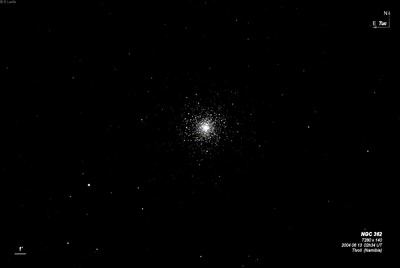
James Dunlop discovered NGC 362 = D 62 on 1 Aug 1826 with a 9" speculum reflector and described "a beautiful bright round nebula, about 4' diameter, exceedingly condensed. This is a good representation of the 2nd of the Connaissance des Temps [M2] in figure, colour, and distance; it is but a very little easier resolved, rather a brighter white, and perhaps more compact and globular. This is a beautiful globe of white light; resolvable; the stars are very little scattered." He observed the globular 11 times (sketched in Figure 3 of his catalogue) and his published position is just 2' NE of center.
John Herschel (h2375) reported it with his 18" reflector from the Cape of Good Hope on 12 Aug 1834 as a "Fine, highly condensed globular cluster; psbM; diameter 4'." On 3 Nov 1834 he called it "vB; vL; psvmbM; round; 5' or 6' diameter; all resolved." Observing the next night, he recorded it as "a globular cluster; vB; vlE; gvmbM. Diameter of more condensed part approx. 60 sec in RA; but there are loose stars to a considerably greater distance, stars 13 or 14 mag all nearly equal and distinct, but run into a blaze in centre." His final observation reads: "globular cluster, vB, very compact; psvmb; 4' across; all resolved into stars 13..15 magnitude."
There was a 1.0 tmin error in reduction in the NGC position too far west (Dreyer, IC 2 notes). This error was noted in Harvard College Observatory NGC corrections.
400/500mm - 18" (7/6/02 - Magellan Observatory, Australia): At 228x, NGC 362 appeared very bright and well-resolved into a couple of hundred stars! The rich halo was plastered with stars and extended to nearly 8’ diameter. The 2' compressed core was well-concentrated to a blazing center (concentration class III). Stars appeared to stream out of the core in curving spiral lanes. This globular had a classic symmetric appearance with a prominent, round core and halo. NGC 362 is situated just north of the SMC, though 47 Tuc (NGC 104) overshadows the splendor of NGC 362.
Naked-eye - (11/4/12 - Coromandel Peninsula, New Zealand): this 6.6-magnitude globular was just visible naked-eye to the north of the SMC.
Notes by Steve Gottlieb
NGC 7205
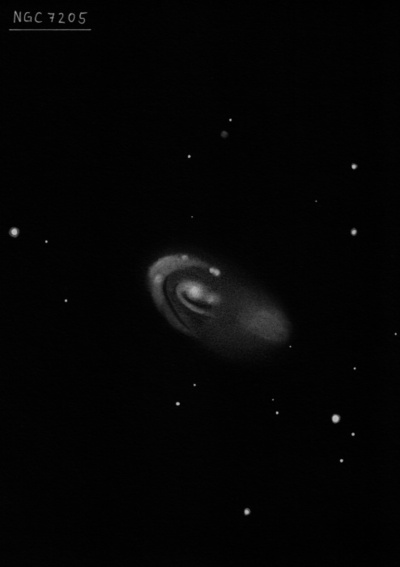
John Herschel discovered NGC 7205 = h3919 on 10 Jul 1834 and recorded "pB; lE; glbM; 2 1/2' l, 1 1/2' br." Member of the Pavo-Indus Cloud along with NGC 7213, 7049, 7083 and 7144.
400/500mm - 18" (7/6/02 - Magellan Observatory, Australia): at 228x, this galaxy was surprisingly bright and large, elongated 2:1 WSW-ENE, 3.5'x1.8', increases to a small bright core. The outer halo on the west-southwest end seems to be more extensive but has a noticeably lower surface brightness. A single spiral arm appears to emerge from the core on the north side and wrap around clockwise towards the east! Situated between mag 8.9 SAO 247319 4' SW and a mag 10 star 4' NE. This galaxy straddles the border of Tucana and Indus and is close to the southwest corner of Grus.
Notes by Steve Gottlieb
NGC 292
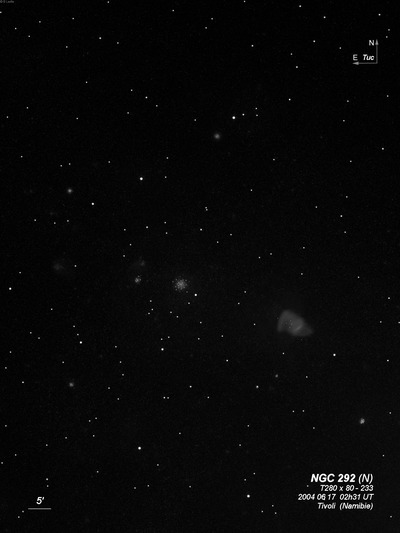
Amerigo Vespucci was the first northern hemisphere explorer to see the SMC in 1501, 20 years earlier than Magellan. This was mentioned in a 1990 article by Dekker.
John Herschel (h2356) has two entries: "I should consider this to be about the main body of the Nubecula Minor, which is here fairly resolved into excessively minute stars, which are however certainly seen with the left eye." On a later sweep he noted: "Hereabouts seems to be placed the main body of the Nubecula Minor which is a Faint, Rich, Large Cluster of very small stars (12..18) filling many fields, and broken up into many knots, groups, and straggling branches. But the whole is clearly resolved into stars."
Pietro Baracchi observed the region between NGC 220 and NGC 294 over 16 and 17 Dec 1887 using the 48" Melbourne telescope. Along with discovering a few new objects that went uncredited (Bruck 67 near NGC 294, Kron 25, SMC-N45), he wrote "About this region there is a very large cluster of stars scattered in an irregular way - from 12 to 18. This covers more than one field ..with the supposed [GC 166 = NGC 294], there are other small groups surrounded by extremely faint nebulosity; and along this space occupied by the objects from A NGC 220] to N NGC 294] there are several stars which seem to be nebulous. All the region along with these objects the sky is almost continuously covered with a multitude of stars, which render the observations difficult and confusing."
400/500mm - 18" (7/6/02 - 7/10/02 - Magellan Observatory): During a week's stay I went through the most prominent clusters and nebulae in the SMC using the fork-mounted 18" at Zane Hammond's observatory.
Naked-eye - (6/29/02 - Bargo): this number refers to the entire SMC. My first view of the SMC was outside Sydney with Les Dalrymple. I only took observing notes (through a 12") on SMC globular NGC 121 and nearby cluster Kron 3, as well as 47 Tucanae.
Notes by Steve Gottlieb
NGC 330
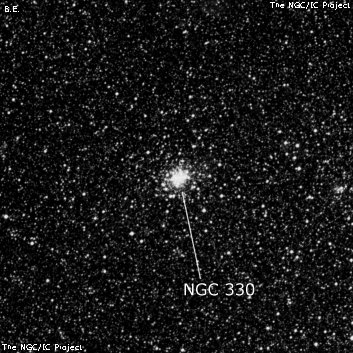
10x30 IS binoculars (11/4/12 - Coromandel Peninsula, New Zealand): visible as a very small, but non-stellar knot.
James Dunlop discovered NGC 330 = D 23 = h2367 on 1 Aug 1826 with a 7" reflector and recorded "A small, but very bright nebula, exceedingly condensed. This is the brightest nebula in the small cloud. I think I perceive two bright nuclei in this body." Dunlop observed the cluster 8 times during his survey and his position was just 2' N of the cluster.
John Herschel observed the cluster on 5 separate sweeps, first recording on 11 Apr 1834, "pretty bright, small, oval, resolved, 60"." His second sweep reads "globular cluster, S, B, little elliptic, gbM; 2' across. Fairly resolved into rather large and not very crowded stars." His third observation reads "globular cluster, vB, S, lE, resolvable or resolved; 90" long, 60" broad; a close compressed knot of stars with outliers."
400/500mm - 18" (7/6/02 - Magellan Observatory, Australia): this is one of the brightest SMC clusters and a fascinating object at 228x. It appears as a bright, extremely rich knot of stars, just 1' to 1.5' diameter, which was only partially resolved. Streaming out from the dense core are numerous mag 12 and fainter stars, some arranged in a curving chain off the following side of the core. The bright outliers seem scattered about to at least 5' (Hodge Association 40). NGC 330 is situated 20' SW of the remarkable HII region NGC 346 within a rich star field!
600/800mm - 25" (10/17/17 - OzSky): at 397x; extremely bright, fairly large, elongated NW-SE, ~1.5' diameter, high surface brightness cluster. Easily over 20 stars were resolved in central region and more than three dozen including outliers around the periphery. NGC 330 is situated in a rich, glowing section of the SMC just 20' SW of NGC 346, the top HII region in the SMC.
Notes by Steve Gottlieb
NGC 346
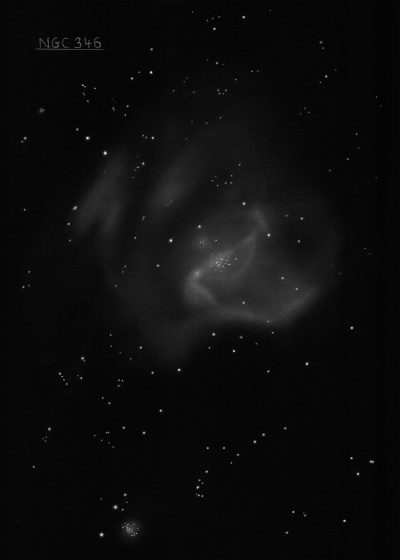
Without the filter, the nebula is set in a rich star field (Hodge Association 45) and a number of stars are superimposed or involved with the nebula, some in the center. NGC 346 hosts 33 O-type stars, several in a small clump including a massive 02-type mag 12.8 star and a mag 12.6 O4-type star. On the NE side is HD 5980, an ultra-luminous mag 11.3 Wolf-Rayet binary (WN4+O7), one of the brightest stars in the SMC. The surrounding region is rich in fainter stars.
NGC 371 is in same low power field 22' NE and NGC 330 lies 21' SW. The small clusters NGC 306 and 299 lies 22' WSW and 26' W, respectively.
10x30mm and 15x50mm: NGC 346 is easily visible in binoculars.
James Dunlop discovered NGC 346 = D 25 on 1 Aug 1826 with his 9" speculum reflector and recorded a "pretty large, pretty bright nebula, about 2.25' diameter, irregular round figure, resolvable, very slight condensation, not well defined at the edges. He observed it on 7 occasions and his position is unusually accurate.
John Herschel gives 5 descriptions in his Cape observations: He first observed it on 11 Apr 1834 as "B, L, pmE, pgmbM, 5', resolvable (ill seen, below the pole)." On a second sweep he called it "Cluster, imperfectly resolved; rather irregular figure; 5' diameter. Not equally condensed about centre; fades imperceptibly; has a double star (12th mag) in centre." His third observation was recorded as "B, L, irregularly round, gmbM, 3' or 4' in extent, fades away insensibly." His next sweep was recorded as "B, L, neb with resolvable centre; irregularly extended into a kind of broad train as in figure, gently graduating away to the borders. 6' diameter." His final observation was logged as "B, L, irregular figure, with a star 13th mag in most compressed part." His published sketch is in the CGH catalogue on plate IV, figure 6.
Joseph Turner sketched NGC 346 with the 48" Great Melbourne Telescope on 17 Dec 1875, with an "arm" attached on the NW end of bar, hooking to the east. It also shows a very small knot of stars about 0.8' NE of center (plate I, figure 4 "Observations of Southern Nebulae made with the Great Melbourne Telescope 1869 - 1885"). He commented, "It is very unlike H.'s drawing and description; indeed I cannot trace any resemblance between that and its present appearance; and were it not for its position, and the fact that L.S. observed and sketched it on 5th February 1870, I should be in great doubt as to its being the proper object. The position, however, accords with that given by Herschel, and Le Sueur's sketch [plate VII, figure 79] is, in its general features, very like mine, so that there is no room for doubting its identity. The central portion is by far the brightest, being a cluster of stars so very distinct that they could almost be counted; and the nebula here also appears the most dense. From this point it proceeds s.f. for almost 1' 30", terminating in a few very faint stars. Towards the n.p. direction it forms a complete bend or hook, and is here very faint. A little n.f. the main or central portion is a very small and faint round patch, which at times looks like a cluster of very faint stars, but I cannot with certainty determine whether or not it be stars or only nebula, although the night is an exquisite one, being clear and steady."
Although a spectrum taken in 1919 at the Cordoba Observatory of Argentina clearly revealed a gaseous spectrum, Charles Perrine declared "the first true spiral which I have encountered that appears appears to consist almost wholly of gaseous nebulosity." (confusing the spiral morphology with a spiral galaxy).
400/500mm - 18" (7/6/02 - Magellan Observatory, Australia): this is the largest HII region in the SMC and an amazing sight at 171x using a UHC filter. The brightest section is a "bar" extending NW-SE with a well-defined edge along the northern side. Extending from the central region are two sweeping "arms" or extensions, creating an exaggerated "S" appearance similar to a barred spiral galaxy! The longer but lower surface brightness arm is attached at the southeast end of the central region and broadly sweeps towards the west, below the bar. The shorter, but high surface brightness arm is attached at the northwest end and hooks towards the east. These extensions increase the diameter to 8'-10' in total size!
Notes by Steve Gottlieb
NGC 7329
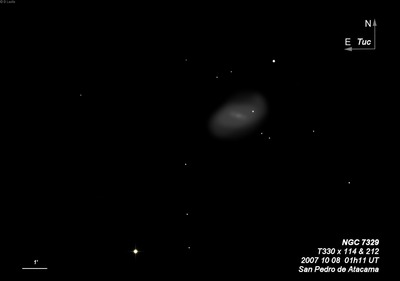
John Herschel discovered NGC 7329 = h3951 on 20 Jul 1835 and recorded "pB; mE in parallel; gbM; 50" l, 20" br." His position is accurate.
600/800mm - 30" (10/14/15 - OzSky): at 303x; bright, very large, oval 5:3 ~E-W, at least 2.5'x1.5', sharply concentrated with a bright, elongated core (bar E-W). The halo is only slightly concentrated but shows weak spiral structure. A mag 12.5 is 3' NW and a pair of mag 14.5/15 stars is off the southwest side and collinear with the nucleus. IC 5235 and 5236 lie 8.4' and 10.6' SE, respectively.
Notes by Steve Gottlieb
NGC 220
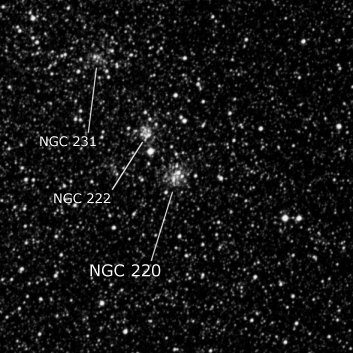
John Herschel discovered NGC 220 = h2338, along with NGC 231, on 12 Aug 1834 in the SMC and recorded "F, vgbM, irregular figure." On a second sweep he wrote "The first of an irregular string of nebulae and stars which descends at an angle of about 45 degrees from the centre to the edge of the field (i.e. in a north-following direction)." Finally, on a third sweep he recorded "F, R; the field is full of the nebulous light of the Nubecula Minor." Harold Corwin notes that NGC 222 = h2339 may be a 4th observations of this cluster (see notes).
James Dunlop probably made an earlier discovery of NGC 220 = D 2 on 1 Aug 1826 using his 9" reflector. He described a "faint nebula, about 1 1/2' long, irregular figure, rather branched. This is involved in the margin of the Nebula minor." His position is 3.6' NW of NGC 220, though given his general poor positions this identification is not certain. Herschel assigned D 2 to NGC 231 = h2340 instead.
Pietro Baracchi observed the cluster on 16 Dec 1887 (first of 14 objects) with the Melbourne telescope and called it "pB, irr, pS, lBM, amidst stars."
400/500mm - 18" (7/10/05 - Magellan Observatory, Australia): at 228x, this SMC cluster appeared moderately bright, fairly small, round, ~50" diameter, brighter nucleus. There was no resolution except for a single faint star near the center. A mag 11 star lies 1' NE and just south of NGC 222. NGC 220 is the first of three in a chain with NGC 222 1.5' NE and NGC 231 4.0' NE. Also NGC 176 lies 24' NW. NGC 220 is located at the west edge of a large SMC star cloud (Hodge Association 3).
Notes by Steve Gottlieb
NGC 7733
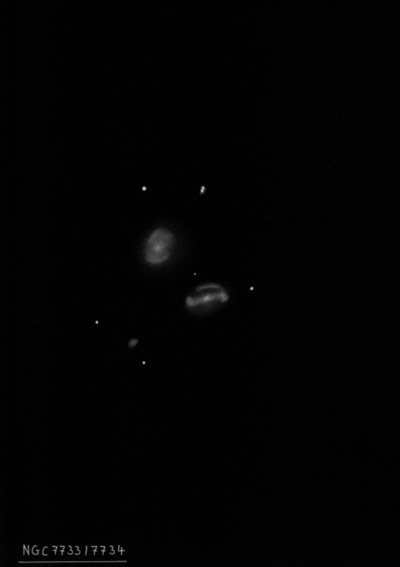
John Herschel discovered NGC 7733 = h4001, along with NGC 7734, on 2 Nov 1834 and logged "eF; S; R; the p of 2; pos from the other = 210°."
600/800mm - 25" (10/15/17 - OzSky): at 244x and 397x; fairly faint, fairly small, roundish, 35" diameter. Very weak, if any, concentration. Forms a close interacting pair with slightly brighter NGC 7734 1.25' NE. Located 25' NE of mag 6.9 HD 222272. On the DSS and Arp-Madore images, both galaxies are highly disturbed.
Notes by Steve Gottlieb
NGC 371
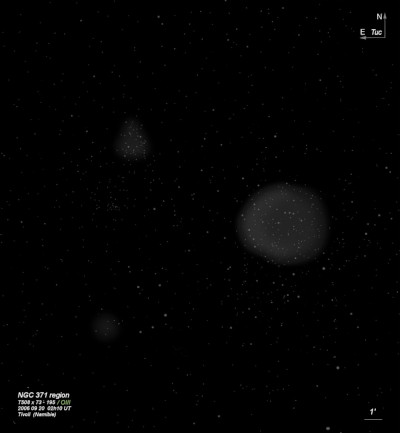
10x30mm and 15x50mm IS binoculars: easily visible along with NGC 346.
James Dunlop discovered NGC 371 = D 31 = h2376 on 1 Aug 1826 with his 9" reflector at Parramatta and recorded "a pretty large unequally bright nebula, about 5' diameter, round figure, resolvable into stars of mixt magnitudes." He made 5 observations and his published position is 8' too far south.
John Herschel made 5 observations beginning on 11 Apr 1834, recording "cluster, 6th class; faint, round, 10' diameter, stars 15..18th mag." The next observation was logged as "vF, L, p rich cluster, 6th class. Stars 14..15th mag." On a third sweep he noted it as "a F, L, p compressed cl of 6th class. 10' diameter. gbM; stars 12..16th mag - in some parts almost nebulous." The fourth observation was recorded as a "cluster 6th class; stars 12..15th mag, a few = 10th mag and one of 9th mag; much compressed in the middle; fills field and has loose straggling lines and crooks branching off." The final sweep was recorded as "F, L, cl; little compressed; gbM; 7' diam; resolved into stars 14..16th mag." Herschel noted that this may be Dunlop 31.
400/500mm - 18" (7/6/02 - Magellan Observatory, Australia): at 171x and UHC filter, NGC 371 is a fairly bright, prominent, round SMC nebulous cluster, up to 6' in diameter with a fairly well-defined edge. The haze has a pretty consistent high surface brightness and seems suspended in a large, scattered cluster or star cloud (Hodge Association 53). A 5' string of four mag 10-11 stars oriented NW-SE is superimposed on the glow (one is mag 13.0 WR star SMC AB 7) as well as a number of fainter stars. SMC AB 6, another mag 12 WR binary, is at the south end. This is an excellent low power field with the striking HII region NGC 346 22' WSW and NGC 395/IC 1624 8'-10' NE.
Notes by Steve Gottlieb
IC 5246
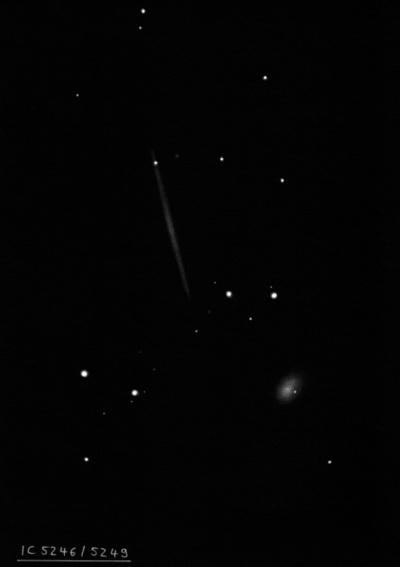
DeLisle Stewart discovered IC 5246 = DS 765 on a plate taken on 21 Aug 1900 at Harvard's Arequipa station in Peru. He simply noted "eF, eS."
600/800mm - 30" (10/15/15 - OzSky): at 303x; fairly faint to moderately bright, moderately large, roundish, ~40" diameter. A mag 15.7 star is attached at the west end. Situated within a group of stars including an elongated group of 5 mag 12-13 stars to the north and east and two mag 11 stars 7' WSW and SSW. IC 5249 lies 5' NE. Located 10' NNW of IC 5250 (bright double system) in a group containing several IC galaxies as well as NGC 7358.
Notes by Steve Gottlieb
IC 5250A
James Dunlop discovered IC 5250 = D 255 = D.S. 768 on 5 Sep 1826 with his homemade 9-inch f/12 speculum reflector. He described a "small faint elliptical nebula in the parallel of the equator, about 25" long and 12" or 15" broad." His position is just 3' following this interacting pair of galaxies (similar in appearance to the Antennae). DeLisle Stewart found the galaxy on plates taken 21 Aug 1900 at Harvard's Arequipa station in Peru, published a fairly accurate position and described "cB, S, R, F * f 0.5'." Stewart is credited with the discovery in the IC.
600/800mm - 30" (10/15/15 - OzSky): at 303x; excellent merged pair within a common halo! Both galaxies are bright, fairly small, high surface brightness, and both contain very bright nonstellar nuclei. The merged system is elongated E-W with the brighter galaxy (IC 5250B) on the east side. The common halo extends perhaps 1.5'x0.75'. (IC 5250B is slightly elongated NW-SE and a mag 13.5 star is superimposed on the southeast edge. A mag 13.2 star is 1.2' SE. The center of(IC 5250A is just 30" to the west and not quite as bright as(IC 5250A. Each component is roughly 0.6' in size. (IC 5250 is the brightest in a group that includes NGC 7358 12' SW, superthin IC 5249 14' N, IC 5246 10.5' NNW and IC 5247 13' SSW.
Notes by Steve Gottlieb